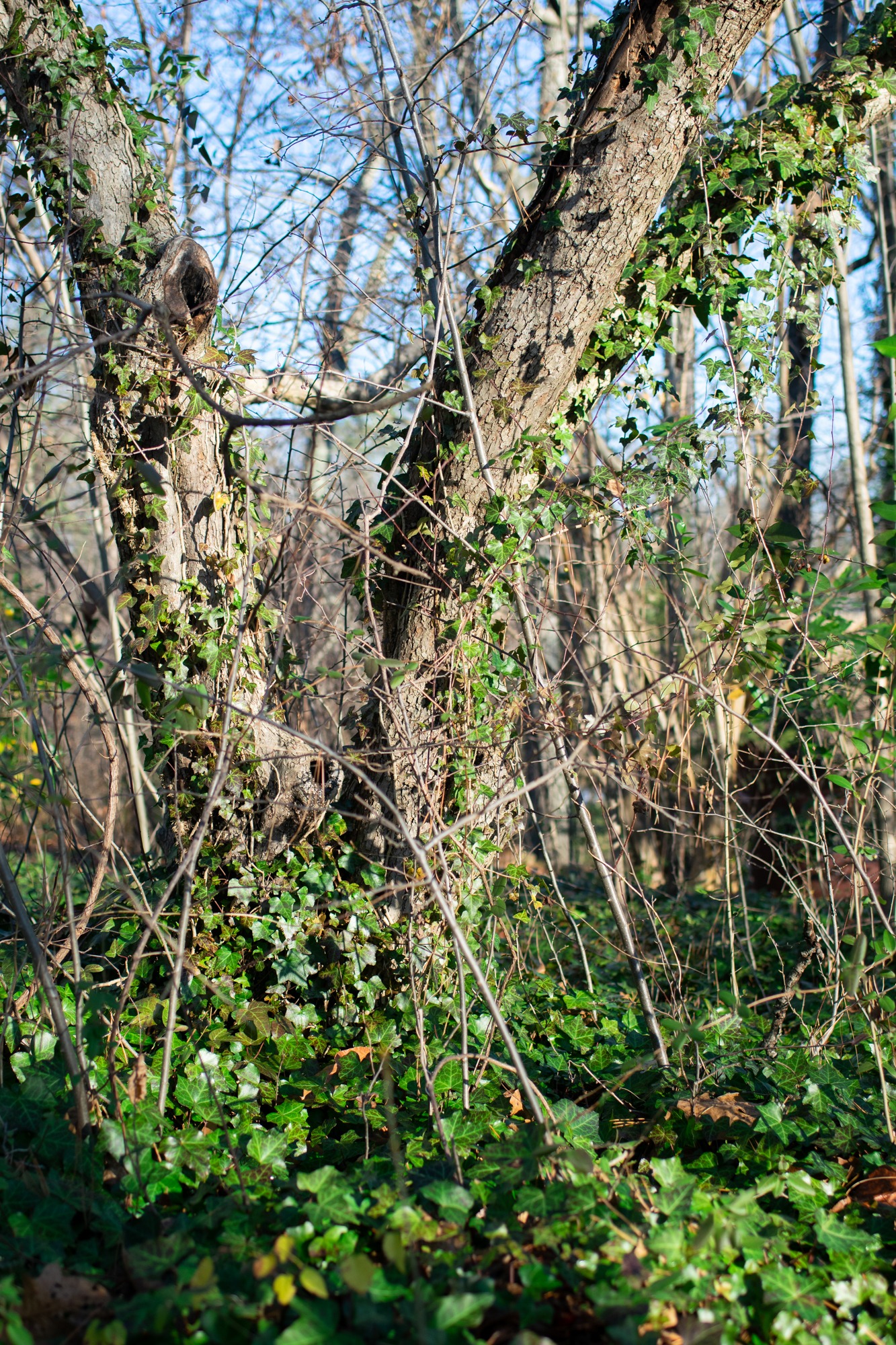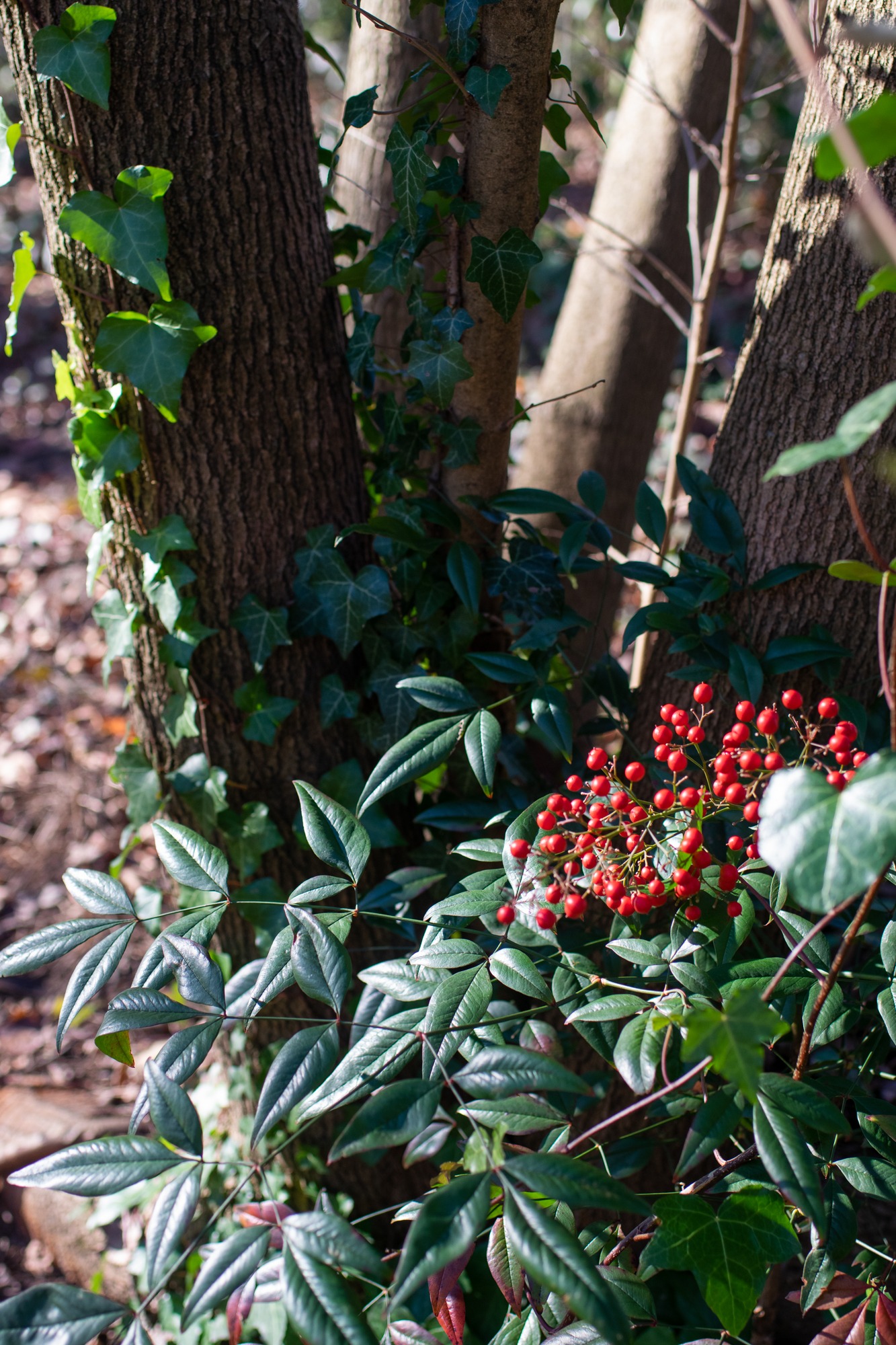Invasive Plants: The “Dirty Dozen”
Meet the Plants
Over the next few weeks, we will be introducing 12 of the most problematic invasive plants that you’ll encounter in Central Virginia. Unfortunately, we also have to battle these even at Lewis Ginter Botanical Garden! While our list is by no means comprehensive for Virginia, Richmond, or even our Garden, we have chosen to highlight twelve that cause significant ecological harm, spread rapidly, or are commonly sold at garden centers and nurseries. You can visit the U.S. Department of Agriculture’s National Invasive Species Information Center and the Virginia Department of Conservation and Recreation’s Virginia Invasive Plant Species List for a more comprehensive list.

This tree is consumed by invasive vines Hedera helix (common ivy) and Ampelopsis glandulosa var. brevipedunculata (Amur peppervine). Image by Nicole Plummer.
For each of the blog posts in our “Dirty Dozen” list, we will include the following information: 1) a basic description, such as what it looks like and where it can be found; 2) what you can do to manage it or to help eliminate it from our communities, and 3) if applicable, suggestions for alternative, native plants that are better choices for our local ecosystems—which include humans, too! First, some background.
What Makes A Plant ‘Invasive’?
You may be wondering what invasive plants are in the first place. For a plant to be considered invasive, it must meet two basic criteria: 1) humans have deliberately or accidentally introduced the plant into an area where it did not evolve, and 2) the plants must be ecologically and/or economically harmful to the areas where they have been introduced. According to the Virginia Department of Conservation and Recreation (DCR), the following are common traits of invasive plant species:
- They grow, mature, and spread quickly
- They produce and disperse a lot of seeds
- They out-compete native species for critical resources including light, water, and nutrients
- They require significant amounts of time, energy, and/or money to control
The earlier you detect and remove invasive plants, the easier it will be! Once invasive plants have “made their home” in a space, they are much more difficult to control.
It is also important to make the distinction between invasive and introduced species since there are many non-native species that do not cause harm to the regions where they have been introduced, and some are even beneficial. On the other hand, invasive species (plant, animal, or fungi) pose risks to our conservation lands, parks, farms and even to our own backyards. In fact, they are one of the five major drivers of global biodiversity loss, along with habitat loss, over-exploitation, human population growth and pollution. If you’d like to learn more about invasive plants in Virginia, visit the DCR’s page on invasive plants. A resource specific to #RVA is the James River Park System Invasive Plant Task Force.

Beautiful but invasive Nandina domestic is commonly used as a landscaping plant. Here it is next to a tree covered in ivy, Hedera helix. Image by Nicole Plummer.
What Can We Do?
While we will provide more detail about how to control specific invasive plants as we introduce each of Lewis Ginter’s “Dirty Dozen,” here are some basic tips on how to reduce the spread of invasives in general:
- Learn more about them. This will also help with distinguishing between invasives and their native “look-alikes”.
- When enjoying outdoor activities, prevent the dispersal of seeds from your shoes, clothing, and pets.
- Report them when you see them.
- Stop buying them, and use native plants for landscaping instead. You can visit our Morton Native Plant Garden virtually or in-person for inspiration. There is even a list of nurseries that sell native plants in Virginia.
We all can play an integral role in controlling invasive plant species in our neighborhoods. By doing so, we will have healthier, more diverse communities of plants, insects, birds, reptiles, amphibians and mammals, ultimately impacting the entire food web. It’s critical that we spread the word on invasive plants (though not their seeds) with family, friends, neighbors and peers so that we can continue to enjoy the vast array of ecosystem services in our beautiful RVA.
Stay tuned over the next several weeks to learn how you can stop the “Dirty Dozen”:
- Microstegium vimineum (Japanese stiltgrass)
- Fatoua villosa (mulberry weed)
- Ailanthus altissima (tree-of-heaven)
- Ampelopsis glandulosa var. brevipedunculata (porcelain berry)
- Celastrus orbiculatus (oriental bittersweet)
- Elaeagnus umbellata, angustifolia and pungens (autumn olive, Russian olive and thorny olive)
- Ligustrum sinense (Chinese privet)
- Lonicera japonica (Japanese honeysuckle)
- Hedera helix (English ivy)
- Nandina domestica (Nandina/heavenly bamboo)
- Imperata cylindrica (Cogon grass/Japanese blood grass)
- Arum italicum (Italian arum)
Updated 10/21/21